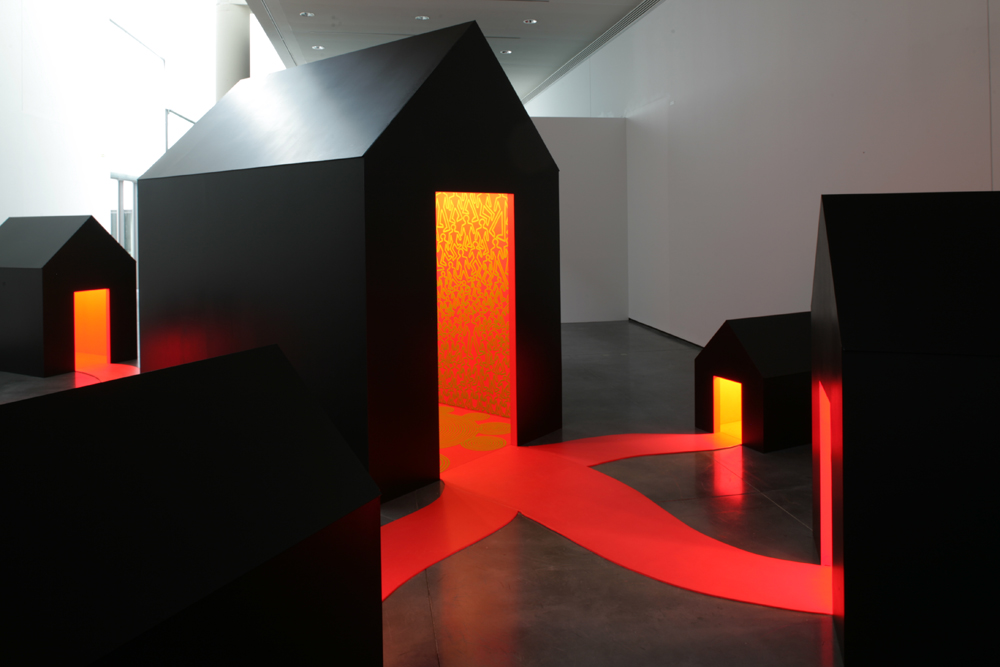The Artist and her Work
Pirjetta Brander was born in 1970 in Helsinki, Finland where she today lives and works.
“Drawing is my mother tongue” This is how Pirjetta Brander likes to describe her art work which she’s been exhibiting worldwide since 1995 in museums and festivals mainly in Finland or Canada. She has also produced installations, paintings and videos initiated by her studies at the Stockholm Art School in Sweden and the Tempere Art and Medias School in Finland. But her work is initially envisaged by her drawings which have numerous sources from hyper-realism, children’s’ drawings, graffiti and outsider art. She proclaims a particular attention to contrasts and details in representations and colour.
Family (self) portrait
Her series of portraits, Me, Mother, Daughter, Granny, are drawings made between 2002 and 2006, revealing a period where she undertook contrasts of the content and the person represented, the drawn line and the contours, following the presence of the colour which suddenly appears from, for example, a necklace, a scarf or even the drawing’s background. These concession-free portraits with sharp and hyper-realist lines, show wrinkles and skin folds which all contain a worrisome and eerie resemblance to the members of her family.
Pirjetta Brander works on family structures, ambivalent and complementary emotions regarding love and tenderness but also exposing its daily insanity and deafening tensions, which she portrays in her video Angst Essen Seele Auf – Portrait of My Family (1999), where she films her own family.
Tree, pyramid, house … links and hierarchies
Pirjetta Brander also explores family structures by extending it to human relationships. Considering the family like a part of society, she uses symbols which demonstrate hierarchy and power struggles according to various degrees and scales – from the family cell to the multitude of social individuals and strangers in society.
In the installation Tower of Glasses (2010), a pyramid of stacked wine glasses – symbol of family and group celebrations and ceremonies – “stand” on a large red stain on the ground, under the table. And then there’s the tree, perfect symbol of genealogy and hierarchy, with its trunks and branches revealing different ramifications which Prijetta Brander depicts in her series of silkscreen prints Bad Love (2000-2001) or in her watercolour Garden (2008).
Another powerful symbol and object which she multiplies is the house, in its most minimally worrisome form, roofless and often with a chimney-place as well as a door like the sole opening, often resembling a keyhole. In the watercolour Field Trip (2007) this recurrent house motif is attached to a rainbow from where a string of uniformed individuals, like a child’s paper-chain.
The Village network: prison or protection
The installation of Village was produced in 2008 during her residence at the MAC/VAL and within the framework of “100% Finland”. The installation consists of a main house connected to six others (smaller ones) and topped with a satellite dish – symbol of both the outside world and pictures from all over the world which is paradoxically a symbol of control, power of the medias, producers of stereotypes and standardisation, an aspect which the artist constantly questions.
So it’s not surprising that the novel L’adversaire (2000) by Emmanuel Carrère, inspired from a real event, absolutely fascinated Pirjetta Brander. This book, after made into a film, retraces the steps of Jean-Claude Romand, a man who killed his entire family in 1993, frightened they would discover his life-lie. For years, he pretended to be a doctor at the World Health Organization working in Geneva. He borrowed money from relatives who believed they were contributing to a worthy financial investment, whereas he spent his days on motorway rest areas where he finally organized this impersonation until the tragedy. The Village thus emits a high-tension ambiance and the artist even speaks of a “visual sauna” to characterize this disturbing experience. The “mother-house” epitomizing the heart of the village, is interfaced to six other smaller houses by paths, large red-tinted vinyl blocks similar to blood vessels, upon which the visitor can wander. A strong light radiates from the seven houses, confirming the idea that these are households. This grouping makes us think of tales like Hansel and Gretel, Little Red Riding-hood or even the video Marsu (2003) where the artist filmed her own daughter dressed up like a princess, moving about and singing. The artist takes these recordings in playback where this little girl then seems to express her emotions in an angry and bitter way.
Each house in the Village is painted black outside and red inside, a background with frescos of green motifs, arabesques and crowds of one-armed, one-legged people … nothing is normal. Along the paths everyone wants to escape from this overwhelming hive of activity to attain the clouds covering the house’s ceiling. A sky which is either liberating or threatening like in her silkscreen painting Le Nuage noir, created for the International Women’s’ Day, where we see an electric wire coming out from one of the houses which becomes worrisome with the grimly-looking clouds, ready to pour down with rain …
This work also clearly relates the artist’s concern for this other asymmetry and hierarchy which constitutes man-woman relations, notably in the art world where women artists are highly under-represented, even in Finland. “My work can be regarded like a map”, which the visitor may choose to either interpret literally or not.
